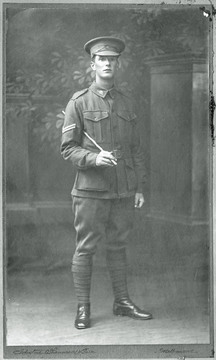LANCE CORPORAL ROY SHIRLEY BROOKES, 47TH BATTALION AIF
Roy was born on the 30th March 1893 in North Fitzroy, Victoria. He lived in North Fitzroy, and later Ivanhoe when his family moved there. As a young man, Roy was a keen member of the Victorian Mounted Cadets.
When the 1914-18 war broke out, Roy was a station hand in the Channel Country of Queensland. He enlisted at Charleville on 15 November 1915, joining the 15th Battalion, 16th Reinforcement (Queensland and Tasmania), Regimental Number 5048.
With his unit he departed Sydney on HMAT A16 "Star of Victoria" on 31 March 1916 for Egypt. As part of the expansion of the AIF, the 15th Battalion was divided, and Roy joined the newly formed 47th Battalion. He served in the 47th for the rest of the war, with the rank of Lance-Corporal. Roy was a Lewis gunner.
Roy was wounded in the back and hands during the Mouquet Farm assault in September 1916. He was wounded again during the Messines attack in June 1917, in the foot. Several months in hospital in England followed.
Early morning on 28th March 1918, saw the 47th Battalion holding the railway embankment between Dernancourt and Albert, after being rushed south from Belgium to stem the major German advance on the Somme. While firing his Lewis gun during a German attack, Roy was severely wounded. Roy believed he was hit by machine gun fire, but the official account (reference below), suggests a German hand grenade caused his wounds in the neck and both thighs. On being wounded, Roy rolled off the embankment into the drainage ditch. Some German soldiers looked at him but left him for dead. Later when it rained and the ditch filled with water, he was afraid he would drown. He was in the ditch for 36 hours, until rescued by his comrades when the embankment was re-taken.
When Roy fell wounded his Lewis gun was picked up by his mate, Sgt. Stan McDougall, who used it to stem the German attack. Stan was awarded the Victoria Cross for his bravery in this action. As a result, Roy’s Lewis gun is on display in the Australian War Memorial in Canberra. (See; “Official History of Australia in the War of 1914-1918” Vol V by C.E.W. Bean, Chapter VIII “Dernancourt, March 28th. pp 193-197.)
Roy spent 6 months in hospital in England, and the gas gangrene he had developed was successfully treated. He returned to Australia 23 September 1918 and spent a further 6 months in hospital in Melbourne. His wounds left him with a permanent limp.
Roy married Gladys Caroline Gray in July 1921, and later that same year he acquired a soldier settlement dairy farm of 100 acres at Whitelaw, near Korumburra in South Gippsland. Gladys and Roy had 3 sons.
Roy was an active member of the Korumburra branch of the R.S.L. for over 50 years and was a trustee. In 1970 he was made an Honorary Member of the branch. He was 2 IC of the Korumburra VDC during World War 2, holding the rank of Lieutenant.
In 1949 the South Gippsland Group of Melbourne Legacy was formed and Roy was a dedicated Legatee from its inception. He was Group Chairman in 1953 and 1954.
Roy died suddenly on Sunday the 7th January 1973, and was buried in the Korumburra Lawn Cemetery. He was 79 years of age.
Notes by Duncan Brookes, Roy’s grandson. December 2014.
Submitted 30 December 2014
by Duncan BROOKES












